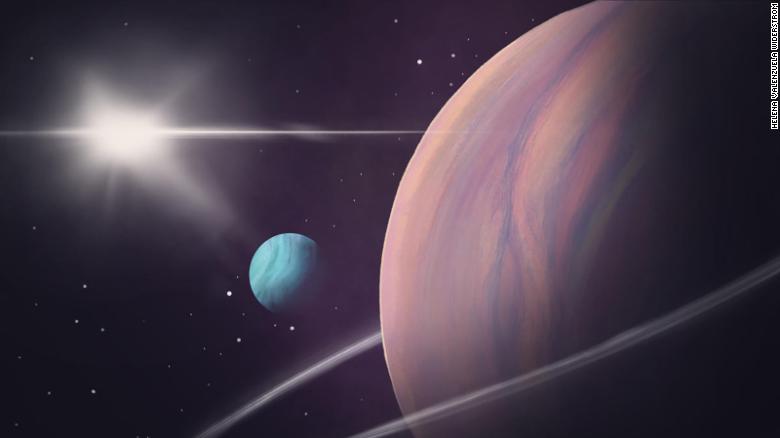(CNN) – Astronomers may have found a moon very different from anything in our solar system.
It’s the second extraterrestrial body discovered that could be an exo moon or a moon outside our solar system. The giant moon has been found orbiting a Jupiter-sized planet called Kepler 1708 b, located 5,500 light-years from Earth.
A detailed study of these findings was published in the journal Thursday Natural Astronomy.
The newly discovered celestial body is 2.6 times larger than the Earth. There is no analogy to such a large moon in our system. For reference, our Moon is 3.7 times smaller than the Earth.
This is the second time David Kipping, assistant professor of astronomy and leader of Columbia University’s Cool Worlds Laboratory, and his team have found a candidate for the outer moon. They discovered the first, a Neptune-sized moon orbiting a giant exoplanet called Kepler-1625b. in 2018.
“Astronomers have discovered more than 10,000 exoplanets so far, but exomoons present a much greater challenge,” Kipping said in a statement. It is an uncharted land (unknown land).
Understanding more about the moons — for example, how they form, whether they can support life, and whether they play a role in the potential habitability of planets — can lead to a greater understanding of how planetary systems form and evolve.
Hard to find items
Kipping and his team are still working to confirm that the first candidate they found is in fact an exomoon, and this latest discovery will likely face the same uphill battle.
Moons are common in our solar system, which contains more than 200 natural satellites, but the long search for interstellar moons has been largely unsuccessful. Astronomers have successfully located exoplanets around stars outside our solar system, but exomoons are difficult to locate due to their small size.
More than 4,000 confirmed exoplanets have been discovered across the galaxy, but that doesn’t mean finding them was easy. Many have been discovered using the transit method, or by looking for dips in starlight when a planet passes in front of its star. Detecting smaller moons that cause smaller dips in starlight is very difficult.
To find this second potential moon, Kipping and his team used data from NASA’s Kepler Retired Planet Search mission to study some of the cooler gas giant exoplanets the telescope has found. The researchers used this criterion in their research because in our solar system, there are the largest number of moons orbiting Jupiter and Saturn in our solar system.
Of the 70 planets they studied, only one revealed an accompanying sign that looked like a moon, with only a 1% chance of it being something else.
“It’s a stubborn sign,” Kipping said. “We threw the kitchen sink on this thing, but it won’t go away.”
3 ways the moon can be formed
The newly discovered candidate shares similarities with the first possible discovery of the outer moon. Both are most likely gaseous, which explains their enormous size, and they are far from their host stars.
There are three main theories about how the moons formed. One is when large space objects collide and separate matter turns into a moon. Another is capture, when objects are captured and placed in orbit around a large planet, such as Neptune’s moon Triton, which is believed to be a captured object in the Kuiper Belt. The third are moons, which were formed from the material, such as gas and dust that orbits stars, that created the planets in the early days of the solar system.
It is possible that both candidates for the outer moon may have started as planets that were eventually pulled into orbit around larger planets such as Kepler 1625b and Kepler 1708b.
Giant moons may be an anomaly
Kipping thinks it’s unlikely that all moons outside our solar system are as large as these two candidates, which might make them odd, rather than standard. “The first discoveries in any survey will generally be rather eccentric,” he said. “Large ones are easy to detect with our limited sensitivity.”
Confirmation of the two satellite candidates will require follow-up by the Hubble Space Telescope and the James Webb Space Telescope in 2023. Meanwhile, Kipping and his team continue to gather evidence to support the exo-moons.
The fact that each associated planet takes more than a year on Earth to complete one orbit around its star slows down the discovery process.
“Confirmation requires repeating the transit to the Moon several times,” Kipping said. “The long-period nature of our target planets means we only have two transits available here, but not enough to see the series of moon transits needed to claim a confirmed discovery.”
If confirmed, it could be the start of a new acceptance that exomoons are as common as exoplanets outside our solar system.
The first exoplanet was not discovered until the 1990s, and most of the exoplanets known today were not discovered until the launch of Kepler in 2009.
“These planets are strange compared to our internal system,” Kipping said. “But they have revolutionized our understanding of how planetary systems form.”

“Proud web fanatic. Subtly charming twitter geek. Reader. Internet trailblazer. Music buff.”


:quality(85)/cloudfront-us-east-1.images.arcpublishing.com/infobae/VWWQ37HV5ZERLPFWQKUG6JD2CQ.jpg)

:quality(85)/cloudfront-us-east-1.images.arcpublishing.com/infobae/V7GOG2JDGBC4BA6UGMQQ7FRZAM.jpg)


More Stories
How can you record your video calls on WhatsApp? This is how it's done on Android – Teach Me About Science
Retro Nintendo games are coming to iPhone: how to install them
How to find out a person's location just by searching for his cell phone number